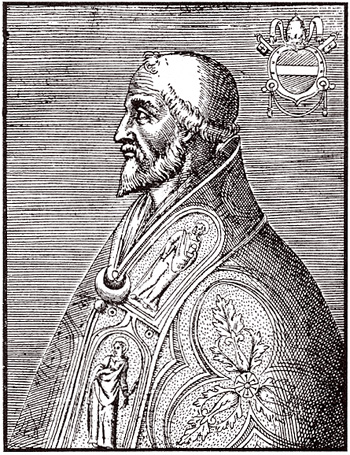 |
The Saint of the Day
St. Leo IX, April 19
Prof. Plinio Corrêa de Oliveira
Biographical selection:
St. Leo IX lived from 1002 to 1054. His life was extraordinary in many ways. He came from a family of high nobility, and carried out every ecclesiastical office he exercised with excellence. When he was Bishop of Tour, he was considered the most handsome man of his time. His exterior appearance was set off by his distinguished elegance in dress and manners. In him the astuteness of the serpent was joined with the innocence of the dove, and for this reason the wise men of his time considered him the most prudent of all. He was so charitable that often he distributed so many of his goods to the poor that he himself was reduced to poverty.

Pope St. Leo IX
|
He excelled in both the human and divine sciences, especially in music. In this field he composed hymns in honor of St. Cyriac, Blessed Odilia and Pope St. Gregory the Great, Apostle of England. Humble and patient, he had an invincible constancy amid trial. The violence of the battle did not trouble him, nor did ambushes surprise him. Every year he used to make a pilgrimage to Rome to venerate St. Peter and the relics of other saints. His strong personality and great virtue raised up hatred against him, but he was deeply loved by the upright souls of his flock.
Comments of Prof. Plinio:
I consider this a monumental description. It is a depiction of a grand seigneur. Pope Leo IX is a saint who had all the characteristics of a grand seigneur - tall, handsome, distinguished in dress, elevated in manners, dignified in everything he did. In this sense one can say that he was a flower of the aristocracy who was plucked by Divine Providence to be placed over the altar.
Along with this exceptional exterior appearance, he had an extraordinary intelligence, a great learning and an erudition that made him famous in his times. This was not a dry erudition, dusty and dead as so often happens. It was an erudition that was alive and vibrant. He was also a musician.
Then, parallel to these qualities he had great virtue and a strong supernatural life. You can see that he had all the qualities necessary to make him a precious vase, a vessel for a singular flower, that is, his spiritual life - for which all his other qualities were ordained.
He had a remarkable sanctity, a hard sanctity, the sanctity of a fighter, of a man who does not become discouraged, who does not step back, who understands that it is natural to face difficulties and so he faces them. Because of this spirit he was victorious throughout his life.
The different moral elements that shaped his sanctity were as complete as his natural qualities. He was very pious, meditative, with a learning turned toward the spirit, toward religion. He was a fighter, a man who carried the cross of Our Lord Jesus Christ. Replete with these many qualities he was raised to the most elevated post that exists, which is to be Roman Pontiff, successor of St. Peter and representative of Our Lord on earth.
Another interesting thing to note is that he was appreciated. He had enemies, but all the wise men of his time valued him. You can see that there was a public opinion that was open to saints, disposed to understand, support and applaud them. St. Leo IX, then, was like a lighted candle placed in a candelabrum that shone in a room that received its light. This was the reason why he was elected Pope and illuminated all of Christendom.
He was one of those men to whom God decided to give a plenitude of marvelous gifts. It would be difficult to say when God shows his splendor more: when He creates persons like St. Leo IX with so many qualities and gifts, or when He makes the spiritual life triumph in men deficient by nature and filled with contradictions. These are two kinds of marvelous works of God, both so great that it is beyond human capacity to compare them.
One can only conclude with this generic statement: that God is admirable in His saints. Each saint is a masterpiece of God. The greatest masterpiece of God, however, is the ensemble of the saints, the heavenly court with the superb irradiation of all the saints, whose various lights shine with multiple and different expressions and are all synthesized in Our Lady, the Mirror of Justice. She is the faithful mirror in which one can contemplate Our Lord Jesus Christ Himself.


  |
| Prof. Plinio Corrêa de Oliveira | |
The Saint of the Day features highlights from the lives of saints based on comments made by the late Prof. Plinio Corrêa de Oliveira. Following the example of St. John Bosco who used to make similar talks for the boys of his College, each evening it was Prof. Plinio’s custom to make a short commentary on the lives of the next day’s saint in a meeting for youth in order to encourage them in the practice of virtue and love for the Catholic Church. TIA thought that its readers could profit from these valuable commentaries.
The texts of both the biographical data and the comments come from personal notes taken by Atila S. Guimarães from 1964 to 1995. Given the fact that the source is a personal notebook, it is possible that at times the biographic notes transcribed here will not rigorously follow the original text read by Prof. Plinio. The commentaries have also been adapted and translated for TIA’s site.
|
Saint of the Day | Home | Books | CDs | Search | Contact Us | Donate

© 2002- Tradition in Action, Inc. All Rights Reserved
|
 |
|